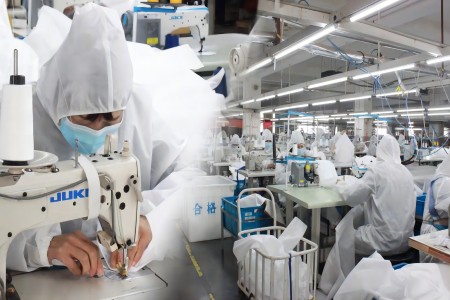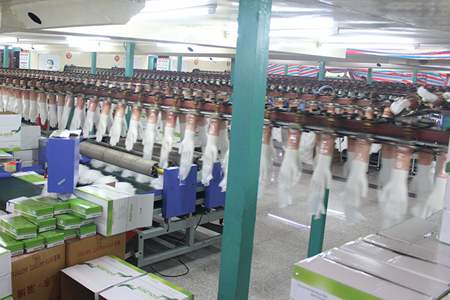2023/9/21

The Evolution of Disposable Protective Coveralls: From Basic to High-Tech
Over the years, disposable protective coveralls have undergone a tremendous transformation. From basic, one-size-fits-all garments to high-tech, customized suits, these coveralls have become an essential piece of equipment for various industries. The evolution of disposable protective coveralls has been driven by the need to provide better protection against hazardous materials and substances. Today, there are numerous options available that cater to specific needs, such as chemical-resistant coveralls, flame-resistant coveralls, and more. The latest advancements in technology have also made it possible to create coveralls that not only offer protection but also enhance comfort and mobility. Whether it's in the healthcare sector, manufacturing, or any other industry, disposable protective coveralls have become an integral part of workplace safety. In this article, we'll explore how these coveralls have evolved over time and the significant impact they have had on workplace safety and efficiency.
The History of Disposable Protective Coveralls
The history of disposable protective coveralls can be traced back to the early 1900s when they were first used in the healthcare industry. These coveralls were made of cotton or linen and were designed to protect healthcare workers from infectious diseases. However, the use of disposable coveralls didn't become widespread until the 1960s when the development of synthetic materials such as polypropylene and Tyvek made it possible to create cost-effective, single-use coveralls.
Initially, disposable coveralls were basic, one-size-fits-all garments that provided minimal protection against hazardous materials. These coveralls were designed to be lightweight and breathable, but they offered little protection against chemicals, biological agents, or other hazardous substances. Despite these limitations, disposable coveralls quickly gained popularity in various industries, including healthcare, manufacturing, and construction.
Basic Features of Disposable Protective Coveralls
Basic disposable protective coveralls are still widely used in various industries today. These coveralls are typically made of non-woven polypropylene or Tyvek, which is a brand of flash-spun high-density polyethylene fibers. They are designed to be lightweight, breathable, and comfortable to wear for extended periods. Basic disposable coveralls typically feature elastic cuffs and ankles, a zippered front closure, and a hood to provide full-body protection.
While basic disposable protective coveralls offer some level of protection, they have several limitations. For instance, they are not suitable for use in environments with high levels of hazardous materials or substances. They are also not flame-resistant, which means they can easily catch fire and cause injuries to the wearer.
Technological Advancements in Disposable Protective Coveralls
To overcome the limitations of basic disposable protective coveralls, manufacturers have developed high-tech coveralls that offer enhanced protection and comfort. These coveralls are made of advanced materials and feature innovative designs that cater to specific needs.
One example of a high-tech disposable protective coverall is the chemical-resistant coverall. These coveralls are made of materials such as Tychem, which is a multi-layered barrier fabric that offers protection against a wide range of chemicals and biological agents. They also feature taped seams and a respirator-fit hood to provide a secure, comfortable fit.
Another example is the flame-resistant coverall, which is designed to protect workers in environments with high levels of heat and flames. These coveralls are made of materials such as Nomex, which is a flame-resistant fabric that can withstand extreme heat. They also feature reflective tape to enhance visibility in low-light conditions.
High-tech Features of Disposable Protective Coveralls
High-tech disposable protective coveralls have several features that make them superior to basic coveralls. For instance, they are designed to be comfortable to wear for extended periods, thanks to features such as breathable materials and ergonomic designs. They also offer enhanced protection against hazardous materials and substances, which is crucial in industries where workers are exposed to such materials on a daily basis.
Some high-tech disposable protective coveralls also feature built-in sensors and monitoring systems that can detect changes in temperature, humidity, and other environmental factors. This information can be used to ensure that workers are working in safe conditions and to identify potential hazards before they become a problem.
Benefits of High-tech Disposable Protective Coveralls
The benefits of high-tech disposable protective coveralls are numerous. For one, they offer enhanced protection against hazardous materials and substances, which is essential in industries such as healthcare, manufacturing, and construction. They are also designed to be comfortable to wear for extended periods, which can improve worker productivity and reduce the risk of injuries caused by discomfort or fatigue.
High-tech disposable protective coveralls also offer cost benefits in the long run. While they may be more expensive than basic coveralls, they are designed to be durable and long-lasting, which means they do not need to be replaced as frequently. They also offer better protection against hazardous materials, which reduces the risk of workplace injuries and associated costs.
Industries that Benefit from High-tech Disposable Protective Coveralls
High-tech disposable protective coveralls are used in various industries, including healthcare, manufacturing, construction, and more. In the healthcare industry, they are used to protect healthcare workers from infectious diseases and other hazardous materials. In manufacturing, they are used to protect workers from chemicals, biological agents, and other hazardous substances. In construction, they are used to protect workers from dust, debris, and other hazards associated with construction sites.
The use of high-tech disposable protective coveralls is also becoming increasingly popular in the food industry. These coveralls are designed to prevent cross-contamination and to protect workers from foodborne illnesses. They are typically made of materials such as polyethylene or polypropylene and feature antimicrobial properties to prevent the growth of bacteria and other microorganisms.
Future of Disposable Protective Coveralls
The future of disposable protective coveralls is bright. With the continued advancements in technology, we can expect to see even more high-tech coveralls that offer enhanced protection and comfort. We can also expect to see more customization options that cater to specific needs and industries.
One area that is likely to see significant growth in the use of disposable protective coveralls is the energy industry. As the demand for renewable energy sources such as solar and wind power continues to grow, so too will the need for workers to install and maintain these systems. Disposable protective coveralls will play a crucial role in ensuring that these workers are protected from hazardous materials and substances.
Conclusion
Disposable protective coveralls have come a long way since their inception in the early 1900s. Today, we have a wide range of options available that cater to specific needs and industries. From basic, one-size-fits-all coveralls to high-tech, customized suits, disposable protective coveralls have become an integral part of workplace safety. The future of these coveralls is bright, with continued advancements in technology and customization options that will ensure that workers are protected and comfortable while on the job.




 WhatsApp
WhatsApp
Send us your message
You can send an email asking for the price and detailed information of this product. We will reply you as soon as we receive your email